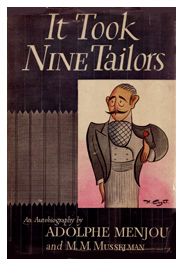

In his 1948 autobiography, It Took Nine Tailors (Whittlesey House), Adolphe Menjou said of "The Grand Duchess and the Waiter," "This picture boosted me up to the top rungs of the Hollywood ladder with such male stars as Rudolph Valentino, John Gilbert, John Barrymore, Tommy Meighan, William Haines and Emil Jannings."
 This says quite a
bit about the popularity of this little-known film, but, according
to Menjou, it wasn't without its problems.
This says quite a
bit about the popularity of this little-known film, but, according
to Menjou, it wasn't without its problems.
Menjou remembered a day in Walter Wanger's office when he said he had a story for him called "Are Parents People?" Although he was taken somewhat aback at playing a father at only 35 years of age, Menjou next questioned whom the director would be. When he was told Mal St. Clair, Menjou shot back, "St. Clair! He's been making Rin Tin Tin pictures with Darryl Zanuck. He's a dog director!" A meeting with St. Clair allayed Menjou's fears, and "Are Parents People?" turned out to be an enjoyable experience for him. A few months after finishing this project, he, Florence Vidor and St. Clair were teamed up again for "The Grand Duchess and the Waiter."
"I knew it was the greatest part I had ever had, and I was in there hitting the line like a sophomore trying for his college letter," Menjou said. "I even suggested to the art department the sort of sets that should be used in the picture. Edward Steichen, the famous photographer, whom I had met during my flight from Paramount, had shot many interiors of the Regina Hotel in Paris. Since most of the picture took place in an old-fashioned Paris hotel, I supplied the art director with a set of these Steichen photographs. He practically duplicated the lobby of the Regina, as well as the rooms I had occupied in the hotel."
Menjou's father was the owner of a fine restaurant, and he grew up working as a waiter - and a good one, too. He explained how difficult it was for him to portray a clumsy waiter in "The Grand Duchess and the Waiter." "I was supposed to know nothing about serving and finally was to spill soup (Note: in the movie, it's cream for her coffee) down her neck. We rehearsed this scene over and over again. I had a terrible time trying to pretend that I didn't know how to be a waiter. After all, when you have been the manager of a high-class restaurant, you don't know the wrong way to serve dinner; you only know the right way. If a cowboy is put on a horse and told to act as though he doesn't know how to ride, he still looks good on that horse. Mal got a little annoyed with me because we couldn't get the scene shot. He finally said, 'Look, Adolphe, don't you understand? You are supposed to look like a bad waiter, not a good one!' 'I know that,' I told him, 'but when I worked in my father's restaurant, he wouldn't tolerate a bad waiter, and I have a suspicion his spirit is right on this set watching every move I make."
Menjou said he and St. Clair both felt good about the picture when it was finished, but they moved on to other projects before the film was cut. Menjou's next project was "The King on Main Street."
"One day as we were making the final scene of 'The King,' Walter Wanger came out to the Long Island studio with a very long face," Menjou remembered. "'What's wrong?' I asked. 'We ran 'The Grand Duchess and the Waiter' last night,' he told me, 'and it's terrible. It doesn't make sense.' I couldn't believe my ears; I knew that we had made a good picture. So we went to the projection room and ran the film again, and Wanger was right. Something had happened to our picture. It had been cut to the bone by some idiot in the cutting department. All the wonderful scenes that Mal and I had labored over were gone. That is the sort of thing that can happen in the picture business. I raised such a row that I could be heard in Times Square. 'I'm taking that picture back to Hollywood,' I shouted. "I'm going to put it back the way we shot it or I will quit!"
Menjou said he left for Hollywood as soon as possible, and he and Ralph Block, writer and associate producer, went to work on "The Grand Duchess and the Waiter." "We worked days and nights reassembling the picture, and we also had to shoot one added scene. When you cut and assemble a picture, you have to view all the film that has been shot - not once but dozens of times. The story soon begins to bore you stiff, and you can't tell whether a scene is funny or not. I began to be worried about the picture and the studio was worried, too. Meanwhile, 'The King on Main Street' was released as my first starring picture. It was such a hit that I was afraid 'The Grand Duchess and the Waiter' would seem very second rate by comparison. By the time we had a master print ready, I was exhausted by work and worry and was practically ready for a hospital."
Of course, Menjou's efforts paid off. "My fears about 'The Grand Duchess and the Waiter' had been needless," he said. "When it was released, it was even bigger than 'The King.' It was listed among the best pictures of the year and was among the best performances I had ever given."